WordPress Plugin: Parse.ly Content Helper
Overview
The Parse.ly Content Helper is a new set of content insights available to WordPress users of the Parse.ly plugin. When viewing the WordPress dashboard and Posts lists, and editing or authoring a post in WordPress, users can rely on the Parse.ly Content Helper for curated analytics, content insights, and information that is otherwise only available within the Parse.ly dashboard. Learn more here on how to install the plugin, and review frequently asked questions on the plugin.
Prerequisites
- General requirements
- Using wp-parsely v3.6 or greater (see our release notes for the latest)
- Using the WordPress Block Editor
- AI Features
- Must be a customer of WPVIP CMS or WPVIP CMS + Analytics
- Provide written consent to opt-in. Submit your request here.
- Customer-type requirements
- WPVIP CMS customers – as of January 2024, we will configure your Parse.ly plugin with the API Secret needed to enable PCH. The API Secret field will not be visible in plugin settings. Contact your account representative(s) to request that we install this secret.
- Parse.ly-only customers – if you have purchased the API, you can find your API Secret in the Parse.ly Dashboard under the “API Settings” menu item. You will need to enter this into your plugin settings. If you have not purchased the API and would like to do so, email your account manager.
Where to find it in WordPress
Dashboard
See the top posts on your site in the last 10 minutes, 1 hour, 2 hours, 4 hours, 24 hours, 7 days or 30 days using our dashboard widget in WordPress. We can rank the top posts by page views or average engaged time.
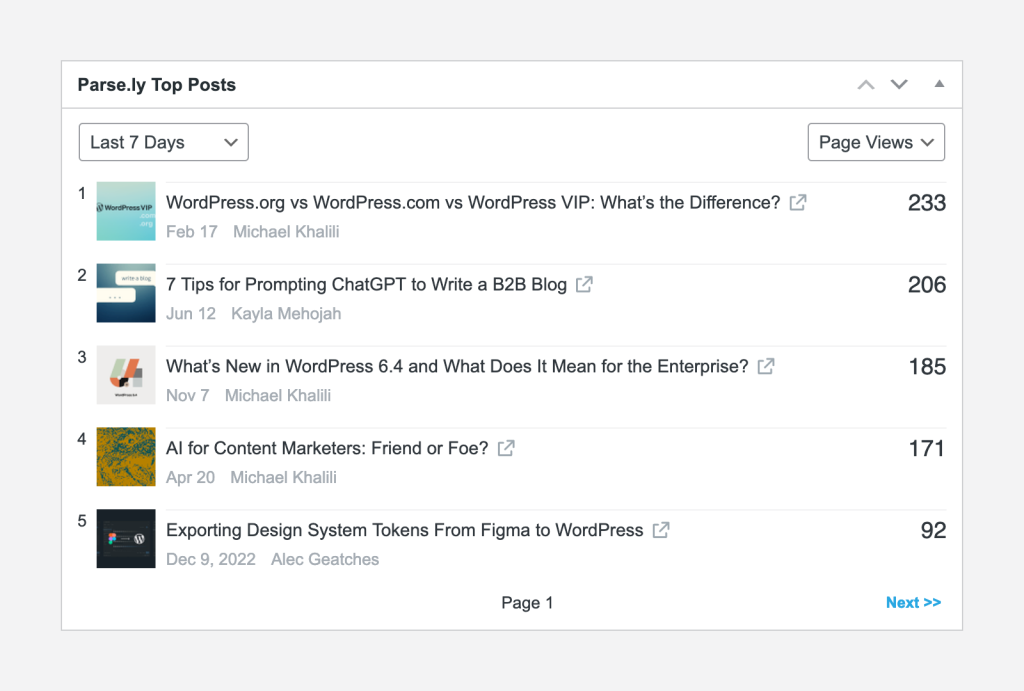
To add this widget to your WordPress dashboard, select Screen Options from the top of the Dashboard page. Then select Parse.ly Top Posts. The widget will now display on the dashboard.

Posts
When viewing or searching for posts in WordPress, you can use the Parse.ly Content Helper to show you data on the performance of published posts for the last days. This data will display in the Parse.ly Stats column for published posts with at least 1 page view.
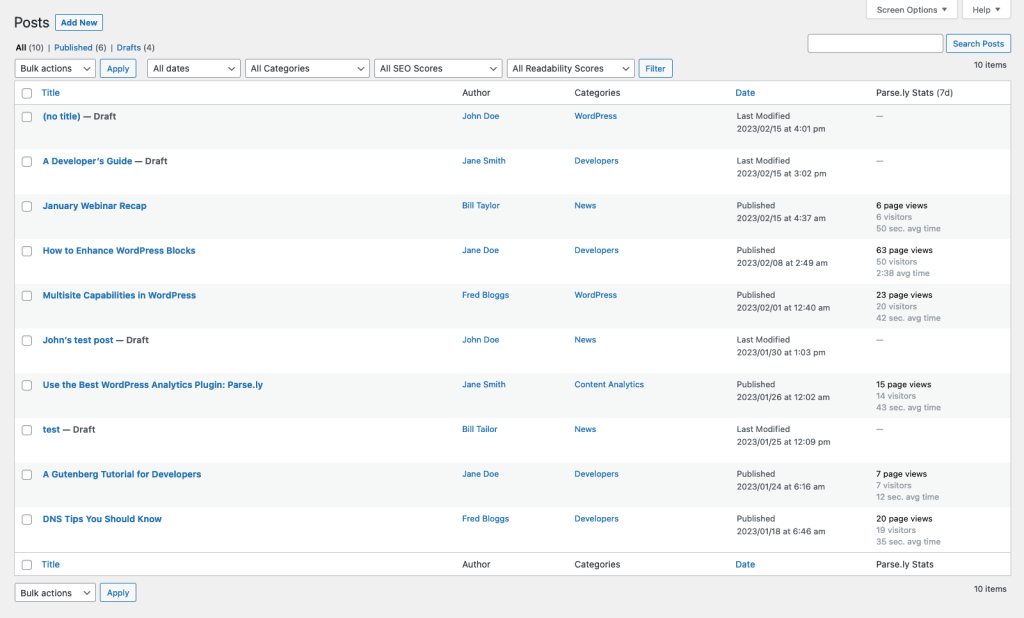
Similar to the dashboard widget, users can add this Parse.ly Stats column to their Posts view by selecting Parse.ly Stats from the Screen Options on this page in WordPress.

Editor
The Parse.ly Content Helper is a curated set of content insights available on any post you’re editing, right from within the WordPress Editor. Users can access the Helper by selecting the Parse.ly icon from the top right navigation of the Editor. The Parse.ly Content Helper contains content insights (Performance Details and Related Top-Performing Posts) as well as opt-in only generative AI (Title Suggestions, Smart Linking, and Excerpt Generator.). These features are visible as a sidebar on the right of the post when editing or authoring.
Settings
From the Settings page you can customize the Parse.ly Content Helper. This includes specifying which user roles can access Parse.ly AI-powered features in the editor.
To access the settings page for wp-parsely:
- Log in to the WordPress Admin dashboard for a VIP Platform WordPress site.
- Select “Settings –> Parse.ly” from the left hand navigation menu in the WP Admin.
Note: Content Helper settings for Parse.ly AI-powered features in the editor require you to upgrade to version 3.16.0 or greater.

How to use the Parse.ly Content Helper in the Editor
See Performance Details 📊

The Performance Details panel shows content insights for the last 10 minutes, 1 hour, 2 hours, 4 hours, 24 hours, 7 days, or 30 days on the post you’re editing:
- Number of views and visitors.
- Average time spent on the page by visitors.
- Referrer data, including direct visits.
From within this panel, it is also possible to open the published post/page to view it on the website, or visit a detailed analytics page on the post within the Parse.ly dashboard.
Use the performance details data to:
- Gain quick insight and context into a post’s recent performance without switching tools or focus.
- Identify channels to focus on for future promotion by reviewing the current top referrers.
It is worth noting that we only display data for published content that has at least 1 view.
Publish smarter and faster
The Content Helper now includes a suite of suite of smart pre-publishing tools powered by Parse.ly AI to help you publish better, faster. Anything Parse.ly AI is opt-in only to ensure our customers have consented to the use of our AI capabilities before adopting them.
To learn more about the API powering our new Content Helper capabilities, see our API documentation.
WordPress sites on the WPVIP Platform have exclusive access to these features: Title Suggestions, Smart Linking, and Excerpt Generator.
Title Suggestions
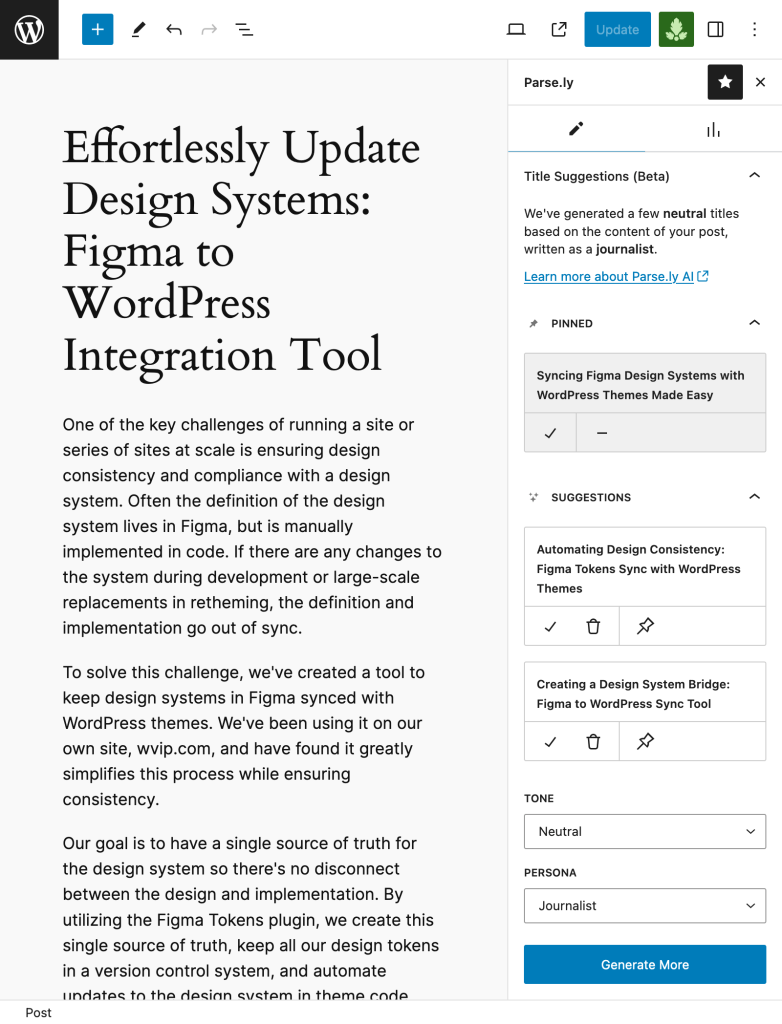
Title Suggestions reviews the content in your draft post alongside your historical archive of content to identify patterns in titles that have performed well on search for a site in the past. It then provides three suggestions at a time for alternative title ideas for a draft post.
Only a logged-in WordPress user with the capability to edit posts can access the Title Suggestions feature while working on a post or a page in the WordPress block editor. While editing a post or a page that has existing content:
- Select the Parse.ly icon labeled “Parse.ly” in the upper right corner of the WordPress editor window to display the Parse.ly settings panel.
- Select the tab labeled with a pencil icon 🖋️ for “Tools“.
- Scroll down through the panel and locate the component labeled “Title Suggestions (Beta)“.
- Configure the options for “Tone” and “Persona” by selecting an option from the dropdown menu:
- Predefined options for Tone: Neutral (default), Analytical, Confident, Conversational, Formal, Humorous, Inspirational, Provocative, Serious, Skeptical.
- Predefined options for Persona: Journalist (default), Business Analyst, Cultural Commentator, Editorial Writer, Environmental Journalist, Health and Wellness Advocate, Political Analyst, Science Correspondent, Tech Analyst. A custom persona can optionally be created by selecting “Custom Persona” from the dropdown and entering the custom persona in the text field.
- Select the button labeled “Generate Titles” to create a list of 3 Parse.ly AI-generated title suggestions within the component. A new list of suggestions can be generated by selecting the “Generate Titles” button again.
- For each listed title suggestion 1 of 3 actions can be taken:
- Accept a title by selecting the checkmark icon labeled “Apply” (Only 1 title suggestion can be applied per post or page).
- Pin a title for later consideration by selecting the pin icon labeled “Pin“.
- Remove a suggestion by selecting the bin icon labeled “Remove“.
Excerpt generation
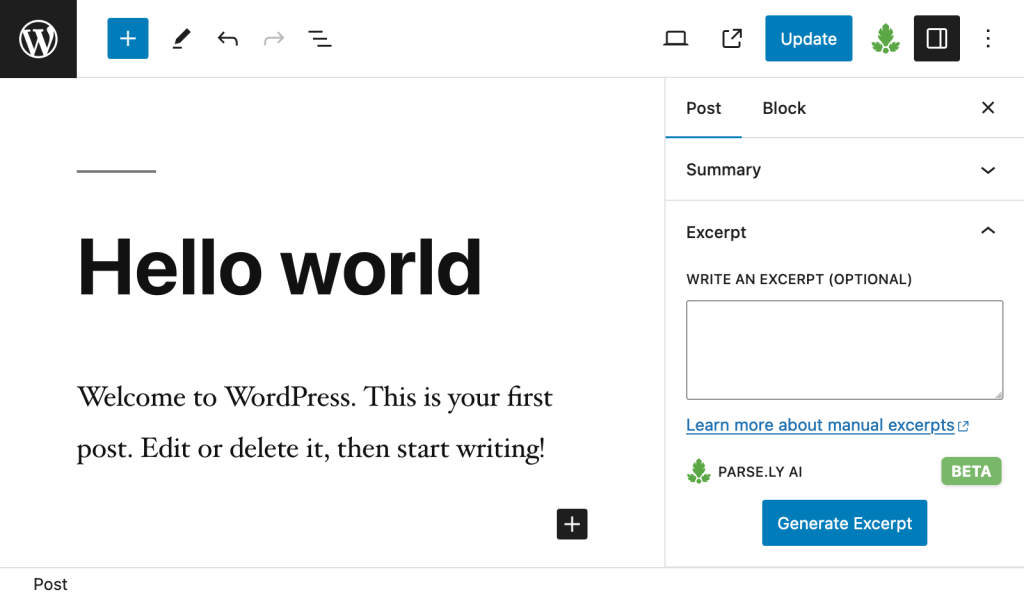
The Excerpt Generator (Beta) is an opt-in AI-powered feature of the Parse.ly Content Helper exclusive to the WPVIP Platform. The feature is designed to optimize the editorial workflow. This feature provides quick and intelligent excerpt suggestions for posts and pages that can improve search engine optimization (SEO) and audience engagement.
Only a logged-in WordPress user with the capability to edit posts can access the Excerpt Generator feature while working on a post or a page in the WordPress block editor. While editing a post or a page that has existing content:
- Select the icon labeled “Settings” in the upper right corner of the WordPress editor window to display the settings panel.
- Select the tab labeled “Page“.
- Scroll down through the panel and locate the component labeled “Excerpt“.
- Select the button labeled “Generate Excerpt“.
The AI-generated content in the “Excerpt” field can be manually updated by the user at any time.
Smart Linking

Smart Linking helps you to quickly add existing, relevant and high-performing posts as links within the post you are editing. Logged-in WordPress users with the capability to edit posts can access the Smart Linking feature while working on a post or a page in the WordPress block editor.
Here’s how to use it:
- Select the Parse.ly icon labeled “Parse.ly” in the upper right corner of the WordPress editor window to display the Parse.ly settings panel.
- Select the tab labeled with a pencil icon 🖋️ for “Tools“.
- Scroll down through the panel and locate the component labeled “Smart Linking (Beta)“.
- In the option labeled “Apply Smart Links To“, indicate the content that the Smart Links feature should be applied to:
- Selected Blocks: The content of the block with an active cursor within it.
- All Blocks: All content in all blocks of the post or page.
- Customize the maximum number of links to be generated within the selected text in the option labeled “Max Number of Links“. Either type a custom integer in the text field or adjust the position of the slider component.
- Select the button labeled “Add Smart Links“.
Content in the selected block(s) will be automatically updated in the content editor. The updated text can be manually updated to adjust the results. Or, undo the generated links with the keyboard command Cmd+Z (macOS) or Ctrl+Z (Windows OS).
Related Posts
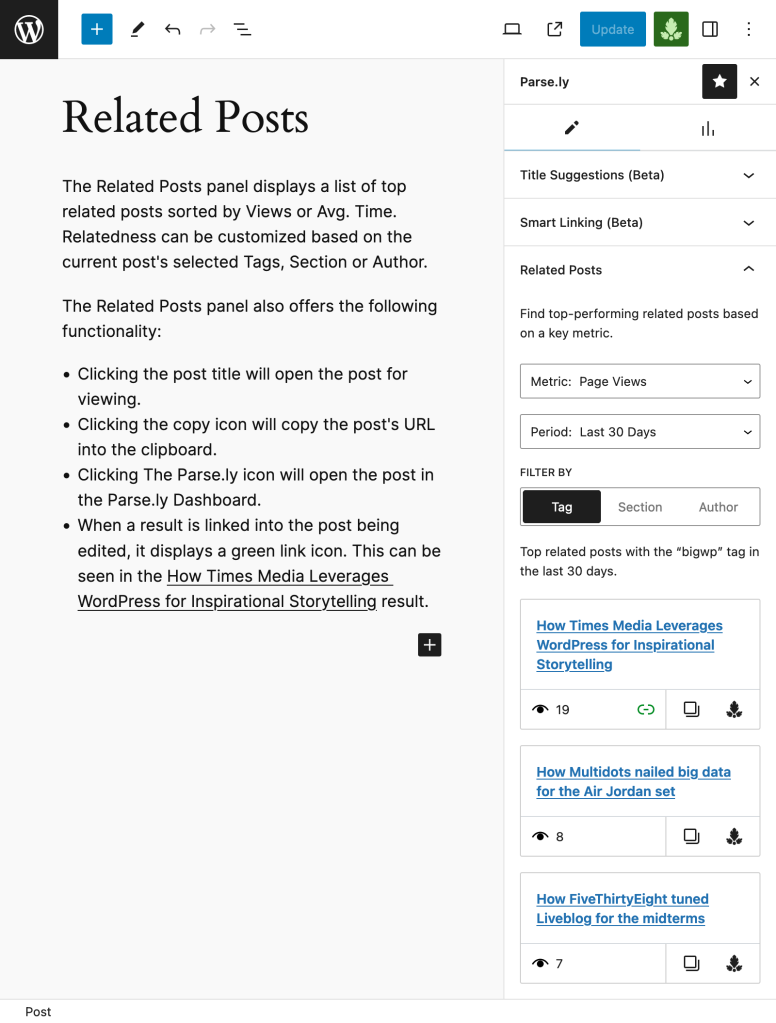
The Related Top-Performing Posts panel provides a list of the website’s most successful posts that are most similar to the content you’re editing. You can filter the related posts shown by two metrics:
- page views
- average engaged time
And you can filter the data used to show related top posts by:
- Tag
- Sector
- Author
This list of content insights is useful to:
- Gain insights and identify patterns on what makes a post successful, in order to write similar content in structure, style, keywords or other criteria.
- Get a list of top-performing related posts for linking purposes from/to the current content. Linking related posts increases depth of engagement with your website and improves the recirculation rate on your content.
- Identify top-performing posts that merit a deeper review; content refresh for evergreen posts, updates to author names, addition of new tags, and more.
From within this panel, it is also possible to open the related published posts, or visit their statistics page on the Parse.ly dashboard.
It is worth noting that:
- The similarity is based on the current content’s
tag,category, orauthor(in this specific order of priority). - Only one of the above is taken into account for similarity at the moment. You can, however, choose which data point you want to prioritize.
- If the content contains multiple categories or tags, only the first category or tag (as returned by WordPress) is taken into account for similarity.
How to disable the Parse.ly Content Helper
We’re sorry if you want to disable the Content Helper, but we understand that this might be needed for your use case. In wp-parsely 3.9 and newer, it is possible to disable the Content Helper using filters. If you are not sure which version you are currently using, please check the plugin settings page, where you will see the version number.
By default, all Content Helper features are enabled. Here are the filters that can be used to disable the Content Helper:
// Disable the Content Helper entirely.
add_filter( 'wp_parsely_enable_content_helper', '__return_false' );
// Disable the Content Helper Dashboard Widget.
add_filter( 'wp_parsely_enable_content_helper_dashboard_widget', '__return_false' );
// Disable the Content Helper Stats Column.
add_filter( 'wp_parsely_enable_content_helper_stats_column', '__return_false' );
// Disable the Content Helper Editor Sidebar.
add_filter( 'wp_parsely_enable_content_helper_editor_sidebar', '__return_false' );
// Disable the Content Helper Excerpt Generator.
add_filter( 'wp_parsely_enable_content_helper_excerpt_generator', '__return_false' );
// The above filters can be used in conjunction. Here's an example of
// disabling all Content Helper features except for the Dashboard Widget.
add_filter( 'wp_parsely_enable_content_helper', '__return_false' );
add_filter( 'wp_parsely_enable_content_helper_dashboard_widget', '__return_true' );Troubleshooting
The Content Helper cannot be disabled using filters
Verify that you’re using wp-parsely 3.9 or newer and that the filters in question return false or '__return_false'.
The Performance Details panel is missing
Verify that you’re using wp-parsely 3.6 or newer, and have access to the Parse.ly content API.
New WPVIP customers – as of January 2024, we will configure your Parse.ly plugin with the API Secret needed to enable PCH. The API Secret field will not be visible in plugin settings.
Other WPVIP customers – you will require a Parse.ly API Secret to enable these features. Contact your account representative(s) to request that we install this secret.
Parse.ly-only customers – if you have purchased the API, you can find your API Secret in the Parse.ly Dashboard under the “API Settings” menu item. You will need to enter this into your plugin settings. If you have not purchased the API and would like to do so, email your account manager or support@parsely.com.
The Performance Details panel is not showing any performance data
Verify that the post has been published and received at least 1 page view. If there is still no data, please contact our support team.
The Content Helper does not seem to work correctly
Under the hood, the Content Helper leverages the Parse.ly API to get its data. However, ad blockers or browser tracking protection can sometimes interfere with the Content Helper’s HTTP requests to the Parse.ly API. Please add the website to any applicable allow lists and try again. If issues persist even after doing this, please contact our support team.
Last updated: July 17, 2024